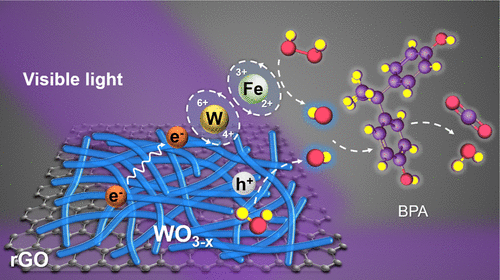当前位置:
X-MOL 学术
›
ACS Appl. Mater. Interfaces
›
论文详情
Our official English website, www.x-mol.net, welcomes your
feedback! (Note: you will need to create a separate account there.)
Solid-Phase Microwave Reduction of WO3 by GO for Enhanced Synergistic Photo-Fenton Catalytic Degradation of Bisphenol A.
ACS Applied Materials & Interfaces ( IF 8.3 ) Pub Date : 2020-06-29 , DOI: 10.1021/acsami.0c06373 Shuning Xiao 1 , Chen Zhou 2 , Xingyu Ye 2 , Zichao Lian 3 , Ningyu Zhang 1 , Junhe Yang 1 , Wei Chen 4, 5 , Hexing Li 2
ACS Applied Materials & Interfaces ( IF 8.3 ) Pub Date : 2020-06-29 , DOI: 10.1021/acsami.0c06373 Shuning Xiao 1 , Chen Zhou 2 , Xingyu Ye 2 , Zichao Lian 3 , Ningyu Zhang 1 , Junhe Yang 1 , Wei Chen 4, 5 , Hexing Li 2
Affiliation

|
The synergistic photocatalytic Fenton reaction is a powerful advanced oxidation technique for the degradation of persistent organic pollutants. However, microwave-induced thermal effects on the formation of novel structures facilitating the photocatalytic degradation have been rarely reported. Herein, a two-step microwave thermal strategy was developed to synthesize a new hybrid catalyst comprising defective WO3–x nanowires coupled with reduced graphene oxides (rGOs). Conventionally, microwave methods could induce superhot spots on the GO surface, resulting in the site-specific crystallization and oriented growth of WO3. However, in the solid phase, localized microwave thermal effects could reduce the interfacial area between WO3 and rGO and enhance the bonding between them. As for the unique structure and surface properties, the synthesized catalyst enhanced the light absorption, promoted the interfacial charge separation, and increased the carrier density in the photocatalytic processes. In addition, surface formation of W4+ provided a new pathway for Fe3+/Fe2+ cycling which linked the photocatalytic reaction and the Fenton process. The optimized catalyst exhibited a remarkable performance in the degradation of bisphenol A with a ∼83% removal yield via a photo-Fenton route. These microwave-induced functionalities of materials for synergistic reactions could also give a new avenue to other photoelectrocatalytic fields and solar cells.
中文翻译:

GO固相微波还原WO3以增强双酚A的协同光-芬顿催化降解作用。
协同光催化Fenton反应是一种强大的高级氧化技术,用于降解持久性有机污染物。然而,很少有人报道微波诱导的热效应对促进光催化降解的新型结构的形成。在本文中,开发了一种两步微波热策略,以合成一种新的杂化催化剂,该杂化催化剂包含有缺陷的WO 3– x纳米线和还原的氧化石墨烯(rGO)。常规地,微波方法可以在GO表面上引起过热点,导致WO 3的定点结晶和定向生长。然而,在固相中,局部微波热效应会减小WO 3之间的界面面积和rGO并增强它们之间的联系。至于独特的结构和表面性质,合成的催化剂在光催化过程中增强了光吸收,促进了界面电荷分离并增加了载流子密度。此外,W 4+的表面形成为Fe 3+ / Fe 2+循环提供了一条新途径,该途径将光催化反应与Fenton过程联系在一起。经过优化的催化剂在双酚A的降解中表现出了卓越的性能,通过光芬顿途径的去除率约为83%。这些材料通过微波诱导的协同反应功能也可以为其他光电催化领域和太阳能电池提供新途径。
更新日期:2020-07-22
中文翻译:

GO固相微波还原WO3以增强双酚A的协同光-芬顿催化降解作用。
协同光催化Fenton反应是一种强大的高级氧化技术,用于降解持久性有机污染物。然而,很少有人报道微波诱导的热效应对促进光催化降解的新型结构的形成。在本文中,开发了一种两步微波热策略,以合成一种新的杂化催化剂,该杂化催化剂包含有缺陷的WO 3– x纳米线和还原的氧化石墨烯(rGO)。常规地,微波方法可以在GO表面上引起过热点,导致WO 3的定点结晶和定向生长。然而,在固相中,局部微波热效应会减小WO 3之间的界面面积和rGO并增强它们之间的联系。至于独特的结构和表面性质,合成的催化剂在光催化过程中增强了光吸收,促进了界面电荷分离并增加了载流子密度。此外,W 4+的表面形成为Fe 3+ / Fe 2+循环提供了一条新途径,该途径将光催化反应与Fenton过程联系在一起。经过优化的催化剂在双酚A的降解中表现出了卓越的性能,通过光芬顿途径的去除率约为83%。这些材料通过微波诱导的协同反应功能也可以为其他光电催化领域和太阳能电池提供新途径。











































 京公网安备 11010802027423号
京公网安备 11010802027423号